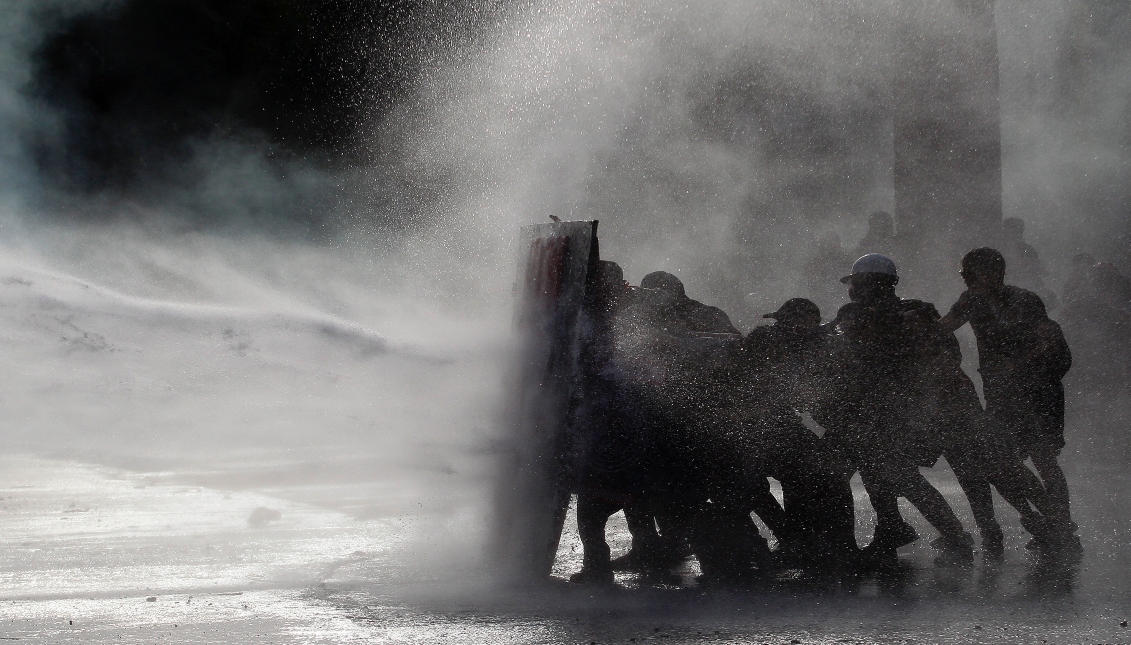
Caustic soda in the water of the "guanacos" of Carabineros de Chile would explain numerous chemical burns in demonstrators
The discovery of caustic soda in a water sample from Carabineros of Chile’s water cannon could explain numerous chemical burns reported by doctors.
"We're caleta
More than the paco'.
We are more choros, we fight without guanaco".
It says one of the stanzas of Mon Laferte's last song, although at the time of writing it, she probably wasn't yet thinking about what has been discovered about the Carabineros of Chile's water cannons (known as guanacos).
Because of the numerous cases of ocular losses reported in Chile, at the beginning of November an effort began to regulate and even prevent the use of pellets by the Carabineros of Chile. The lawsuits that won the ban were then appealed to the Santiago Court of Appeals, which lifted the ban for the entire region on Nov. 29 this year.
However, as of Nov. 22, the medical corps in the emergency rooms began to report an increase in the cases they received for chemical burns.
Mario Rozas, director general of Carabineros de Chile, has stated that the water cannons are loaded with chemicals dissolved in the water, but these only produce burns when there are pre-existing medical conditions. However, according to the presentation of Roberto Macchiavello, surgeon of the Burn Department of the Emergency Public Assistance Hospital, formerly Posta Central, in the Senate Human Rights Commission, these are serious chemical burns that do not correspond to allergies.
General Jorge Ávila, head of the public order control and Carabineros intervention zone, intervened in the same commission. He explained that the water cannons have two tanks: one with drinking water and the other with water mixed with CS, a tear gas. The CS, despite being legal, in high concentrations can have more serious consequences than eye and skin irritation, such as diarrhea, vomiting, severe eye damage and skin burns.
Even so, the burns reported with the doctors do not correspond to those caused by CS gas, as was also demonstrated by the Carabineros Criminalistics Laboratory, since according to the experiment carried out by them, CS burns occur after four hours of exposure to CS powder.
Yesterday there was a response to the reason for the burns at the press conference given by the collective Movimiento Salud en Resistencia, where they presented an independent study of two water samples taken on November 20 and 22, at the intersection between Ramón Corbalán Street and Libertador Bernardo O'Higgins.
In the November 20 sample, they found the presence of capsaicin, the chemical component that makes peppers itch, also present in pepper gas, but due to difficulties in the analysis they could not determine if there was another component.
RELATED CONTENT
In the sample of 22, in addition to capsaicin, they found sodium hydroxide, that is, caustic soda.
The presence of this highly corrosive element correlates with the type of burns reported by doctors (large blisters filled with water) and with the presence of capsaicin, since it is not soluble in water and sodium hydroxide would be necessary to achieve its dissolution.
The same study specifies some of the health effects of both capsaicin and sodium hydroxide. Capsaicin causes irritation and pain, which can occur in the skin, eyes, nose and respiratory tract. In the case of capsaicin, it can produce such a level of stimulation to the neuroreceptors of pain that the affected person reaches the maximum peak of pain that can be felt.
On the other hand, the symptoms of exposure or poisoning by sodium hydroxide (caustic soda) indicated in the report are diverse and numerous. Among the mildest are drooling, sneezing, and irritation; among the most severe are the appearance of holes in or under the skin, change in blood pH, loss of vision, burns in the esophagus and stomach, and inflammation of the lung.
As a result, Carabineros' logistics director, Jean Camus Davila, has denied the use of caustic soda, arguing that, if so, the number of reported burn cases would be much higher.
On the other hand, the National Institute of Human Rights (INDH) announced that it will officiate to the Ministries of Interior and Health, as well as to the Carabineros of Chile, to know the chemical composition used in the water cannons and the president of the Commission of Citizen Security of the Chamber of Deputies, Miguel Ángel Calisto, will ask the Minister of Interior, Gonzalo Blumel, to investigate the issue.










LEAVE A COMMENT: